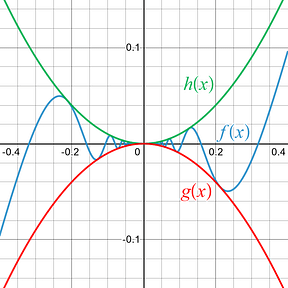Option 11: Squeeze Theorem (Sandwich Theorem)
Definition: Squeeze Theorem (aka Sandwich Theorem)
If for all in some open interval containing .
and
.
Then you know that
Note:
– Essentially what the Squeeze Theorem is saying is that if you have an equation, , that is ALWAYS between two other equations, and , in some x-interval , AND those two equations, and , have the same limit value , L , at the same x-value = c , THEN also has the same limit value, L , at that same x-value = c .
– In other words, and squeeze together to make have the same limit value , L . You could also say that and sandwich between them, forcing it to have the same limit value , L .

– The Squeeze Theorem is not a commonly applied method due to the challenge of finding equations that are always above and below a third equation. There are some very specific uses of it in an AP Calculus course, but this should not be a limit option you immediately look to apply.
